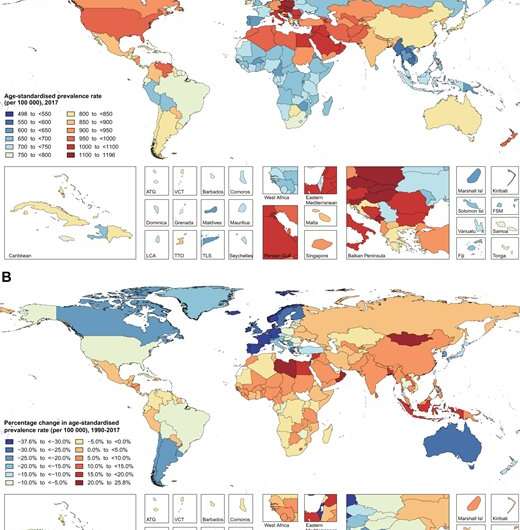Heart failure cases soar globally

The number of patients with heart failure worldwide nearly doubled from 33.5 million in 1990 to 64.3 million in 2017. That's the finding of a study published today in the European Journal of Preventive Cardiology, a journal of the European Society of Cardiology (ESC).
"Our study challenges the common view that heart disease is fully under control," said study author Dr. Nicola Bragazzi of York University, Toronto, Canada. "Despite progress and achievements, the global burden imposed by heart failure is significantly growing."
The analysis used data from the Global Burden of Disease Study to examine the burden and causes of heart failure from 1990 to 2017 in 195 countries and territories. The age-standardized prevalence rate showed a slow downward trend, suggesting that population aging and growth are responsible for most of the increase in prevalence.
The study revealed major differences between regions of the world. The researchers used the socio-demographic index (SDI) to categorize the 195 countries and territories into five groups according to development status: low, low-middle, middle, high-middle, and high SDI. Between 1990 and 2017, the age-standardized prevalence rate of heart failure decreased by 20.3% in high SDI countries but increased in the low, low-middle, and middle SDI countries.
The authors said the rising prevalence rate of heart failure in the low, low-middle, and middle SDI countries "is driven by a surge of risk factors such as hypertension, diabetes mellitus, obesity, smoking, and other unhealthy lifestyles."
Nearly half of the global increase in the number of heart failure patients during 1990 to 2017 was in China (29.9%) and India (16.6%). Dr. Bragazzi said: "An interplay of factors such as population growth, unhealthy behaviors including smoking, and air pollution are likely explanations."
The symptoms of heart failure can be debilitating. Shortness of breath, fatigue and fluid retention may limit patients' ability to walk, stand, work or care for themselves. The study found that years lived with disability due to heart failure have doubled worldwide since 1900, while the age-standardized rate remained stable.
There were stark differences in disability according to SDI category. A large decline in the age-standardized rate of years lived with disability was observed in high SDI countries—which the authors attributed to better prevention and treatment of heart failure. After an initial rise in high-middle and middle SDI countries, rates began to decline in 2010. But the rate continually deteriorated in low and low-middle SDI countries.
The authors said: "In low- and middle-income countries, the compliance to healthy lifestyle behaviors including healthy diets, physical activity and smoking cessation was rather poor." They added that four basic cardiovascular medicines (aspirin, beta-blockers, angiotensin-converting enzyme inhibitors, and statins) were generally unavailable or unaffordable for many populations in low and middle-income countries. "More targeted strategies aimed to modify multiple risk factors and improve the availability and affordability of medical care for heart failure are urgently needed for these countries," said the authors.
Ischaemic heart disease, hypertensive heart disease, and chronic obstructive pulmonary disease (COPD) were the top three causes of heart failure, accounting for nearly three-quarters of the age-standardized prevalence rates. There were regional differences—for example, COPD was a major cause of heart failure in South Asia and East Asia, where smoking and air pollution are contributors.
Dr. Bragazzi said: "Heart failure is a global public health concern. Public health workers and policymakers can use the data provided in this study to design interventions to prevent and manage heart failure in their countries. In addition, educational campaigns are needed to increase awareness about the importance of adopting healthy lifestyles."
More information: Burden of heart failure and underlying causes in 195 countries and territories from 1990 to 2017. Eur J Prev Cardiol. 2021. DOI: 10.1093/eurjpc/zwaa147.




















